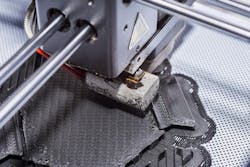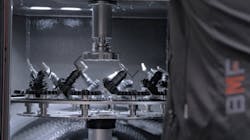Utilizing 3D Printing to Reduce Unplanned Downtime
In today’s fast-paced world of manufacturing, where every minute counts and efficiency is key, unplanned downtime poses a significant challenge. It’s like a silent troublemaker that can suddenly disrupt production lines, causing delays, financial losses and headaches for businesses. Whether a food processing plant is trying to meet tight deadlines, a car factory is striving for smooth operations or an aerospace company is ensuring safety in the skies, the impact of unplanned downtime can be felt across the board.
Despite knowing the risks, many OEMs still take a reactive approach to downtime. When their customer’s equipment breaks down, they scramble to fix it, losing the customer’s valuable time and money in the process. Why wait for disaster when there are solutions available?
The era of reactive downtime management is ending with the integration of 3D printing technology on the factory floor next to where parts for machines are needed—safeguarding profitability, offering a transformative solution and empowering manufacturers to proactively address downtime by reinventing traditional production processes.
READ MORE: A Roundup of Manufacturing Technologies
The Cost of Waiting
Let’s talk numbers: In the past three years, 82% of companies have faced unplanned downtime. This isn’t just a small problem—it affects almost everyone in the business world, big and small. And, with the average hour of downtime costing companies more than $250,000, that’s like losing a small fortune every time something goes wrong.
Additionally, downtime can mess up schedules, upset customers and make businesses look bad. When things break down, orders get delayed and people start looking for other options.
This is where 3D can be used as a tool for machine manufacturers to help them avoid downtime and keep things moving for their customers. By using 3D printers to create replacement and spare parts, companies can plan for problems, fix things quickly and improve the production process.
3D Printing as a Solution
When it comes to solving the problem of unplanned downtime, 3D printing stands out as a solution that is changing how manufacturers work. The technology has become reliable enough that many OEMs rely on 3D printers to produce end-use parts.
One big advantage of 3D printing is that it makes manufacturing more flexible. Companies can make things closer to where they’re needed, which helps save time and money. This is especially useful in industries where even a small delay can cause big problems.
With materials combined with continuous fiber, parts that are made on industrial 3D printers mimic the strength of parts made from aluminum. Not only are the parts much lighter, but they are also able to be printed at a moment’s notice.
Traditional spare and replacement parts are often made in one location, shipped to the OEM and stored until needed. Then, they are shipped out to the point of need. When we are talking about hundreds of thousands of dollars lost for hours of downtime, a machine that is relying on a traditional supply chain to deliver reactionary replacement parts in days is a huge loss for the customer. With 3D printing, when a replacement part is needed, it can be created then and there on the factory floor. With approved files and in-print monitoring, an OEM’s part is ready when the print is finished.
3D printing platforms can also help OEMs manage inventory. Instead of storing spare parts in warehouses based on future projections to ship out as necessary, customers can access digital copies of those parts and print them when they are needed, helping to save space and ensure that companies always have the parts they need.
3D printing also allows companies to make custom parts for specific jobs. Custom tooling, fixtures and jigs for machines are costly to develop and take significant time—particularly in industries like healthcare and defense, where one-size-fits-all solutions do not work and machines are often customized for specific processes. OEMs might not have many, or any, replacement parts ready to go and need to outsource the creation of the parts, adding more time and cutting into more profits.
READ MORE: Sustainable Methods for Metal AM Feedstock Production Revealed in Research Study
How a Machine OEM Uses 3D Printing, Digital Inventory
BMF GmbH invented a device to automate media blasting of small parts, which had typically been a manual operation. The device, the Twister blasting cabinet, has been installed at more than 200 customers worldwide. Because the blasting medium is abrasive, parts within the cabinet need to be replaced twice a year.
Downtime can be expensive for BMF’s customers; a Twister machine can typically sandblast up to 50,000 parts a day. But as the customer base grew in size and distance from BMF’s headquarters in Germany, they needed to look for a new way to provide replacement parts.
BMF used Markforged’s Digital Source platform to enable customers to access a secure digital warehouse that acts as a digital inventory system to print parts on demand. BMF has been able to collapse downtime for its customers from an average of 14 days to one day.
For fixtures, which are custom for each customer, BMF has built in IP protection, and can quickly iterate and update parts for customers. The company is able to continue to grow without overwhelming its limited staff and shop space.
READ MORE: Markforged Offers its FX10 Industrial 3D Printer for Enhanced Factory Operations
About the Author

Tripp Burd
Director of New Platforms, Markforged
Tripp Burd is the director of new platforms for Markforged. He is a thought leader and technology generalist, with a focus on the resolution of high value challenges facing modern manufacturing. A background in composites and industrial consulting helps shape his contributions at the factory floor through the boardroom level. He holds a B.S. in mechanical engineering from Tulane University.


